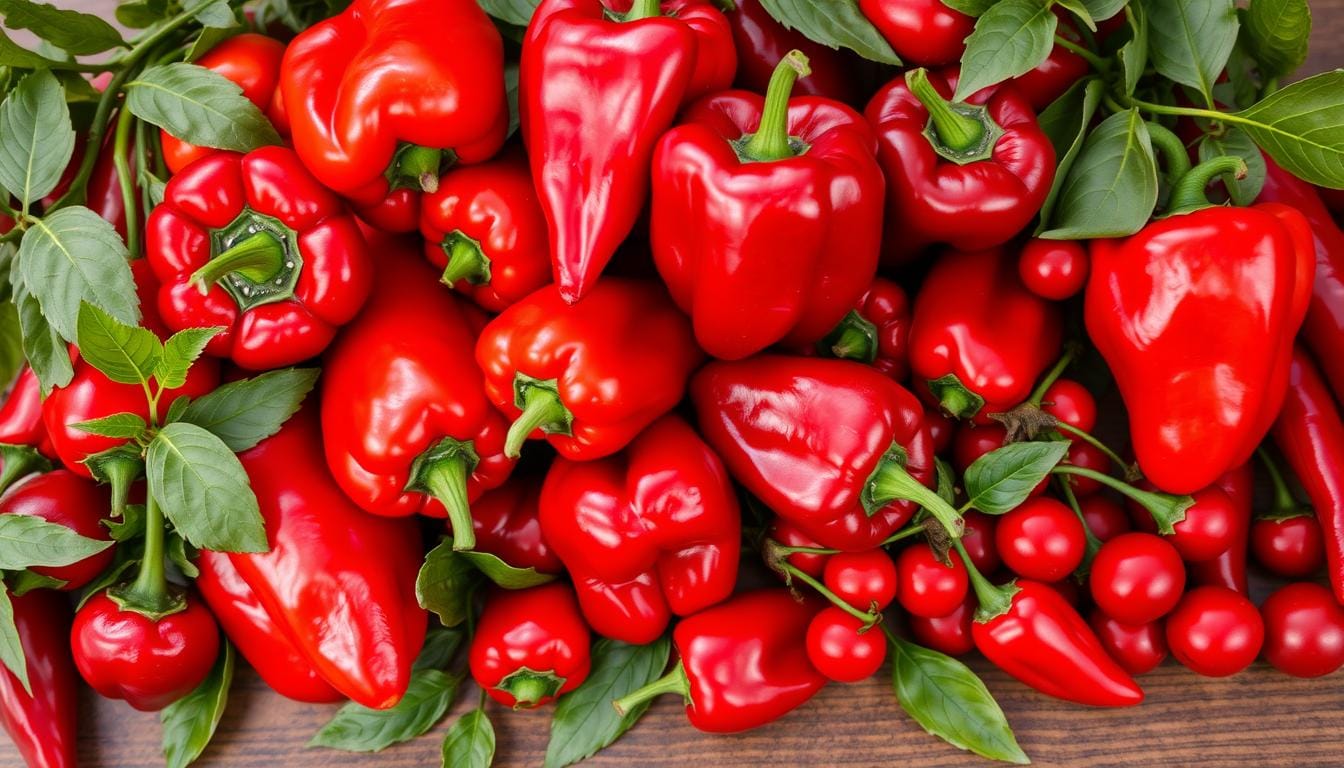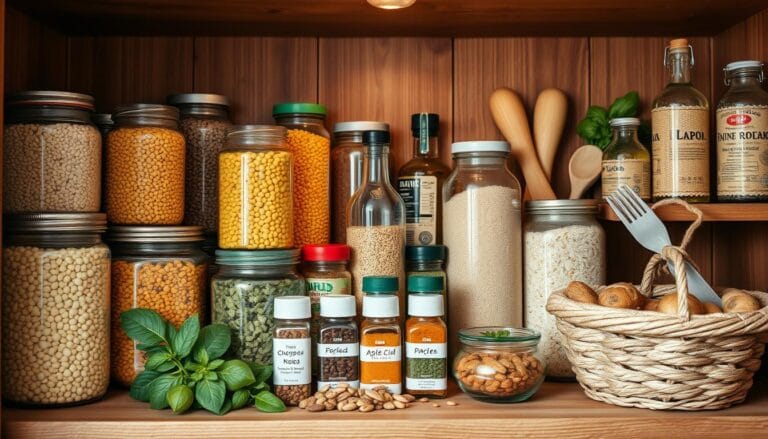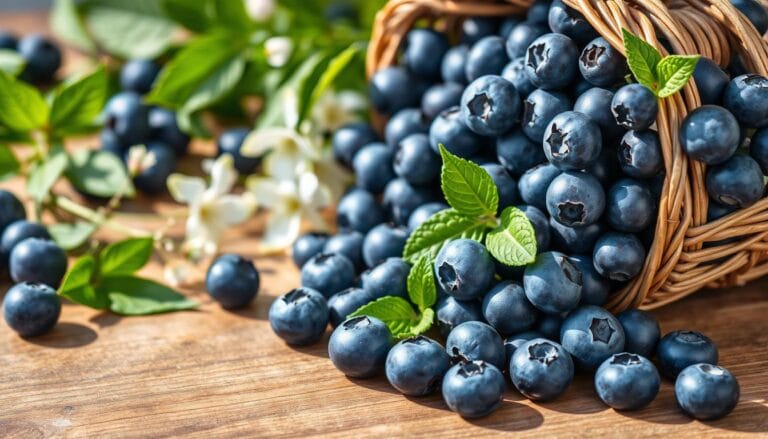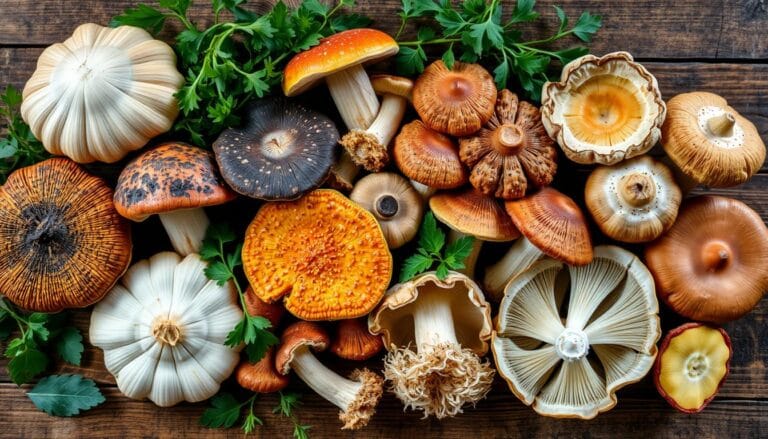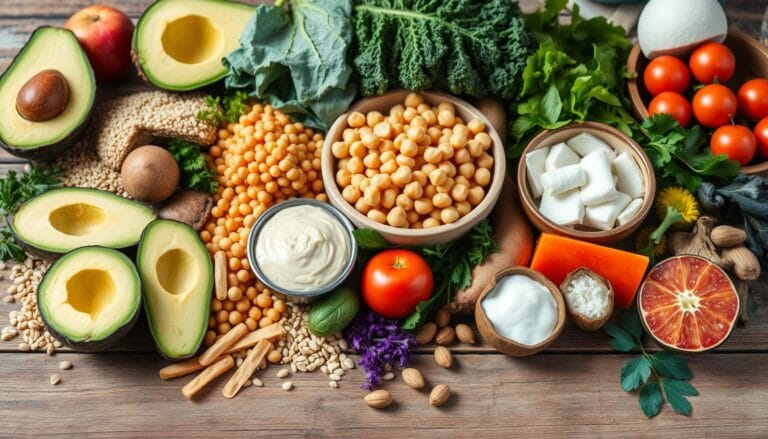Exploring the Different Types of Red Peppers
Every summer, my garden turns into a colorful canvas of red peppers. Each one tells a story of its own, from sweet bell peppers to fiery habaneros. These vegetables amaze me with their wide range of flavors and heat levels.
Red peppers are more than just food. They take you on a journey of flavors that excite your taste buds and test your spice limits. The variety of pepper flavors is vast, from mild and sweet to very hot.
These plants come in many shapes, sizes, and heat levels. For example, red bell peppers are green bell peppers that ripen longer. They become sweeter and more complex in flavor.
If you love gardening, enjoy spicy foods, or just want to learn about red peppers, you’re in for a treat. Exploring the world of red peppers can change how you cook and garden.
Table of Contents
Understanding Capsaicin: The Source of Pepper Heat
Explore the world of pepper heat and learn about the science behind the fiery taste. Capsaicin is the key that makes peppers spicy.
Chemical Composition and Effects
Capsaicin is a strong alkaline molecule that makes your mouth feel like it’s on fire. It has a Scoville scale rating of 16,000,000 SHU. This makes it very potent.
- Molar mass: 305.418 g·mol−1
- Concentration in topical applications: 0.025% to 0.1%
- FDA-approved for pain management in 2009
How Capsaicin Affects Your Body
When capsaicin hits your taste buds, it’s a unique feeling. Your body releases endorphins, which can make spicy food feel good.
| Potential Health Benefits | Medical Applications |
|---|---|
| Metabolism boost | Pain relief creams |
| Fat oxidation | Neuropathic pain treatment |
| Improved circulation | Potential cancer cell research |
Myths About Pepper Seeds and Heat
Many think the seeds are the spiciest part of a pepper. But, the inner white pith has the most capsaicin. This fact changes what we know about pepper heat.
“Capsaicin is nature’s spicy secret, turning ordinary peppers into extraordinary culinary experiences.” – Pepper Enthusiast
The Scoville Scale: Measuring Pepper Heat Levels
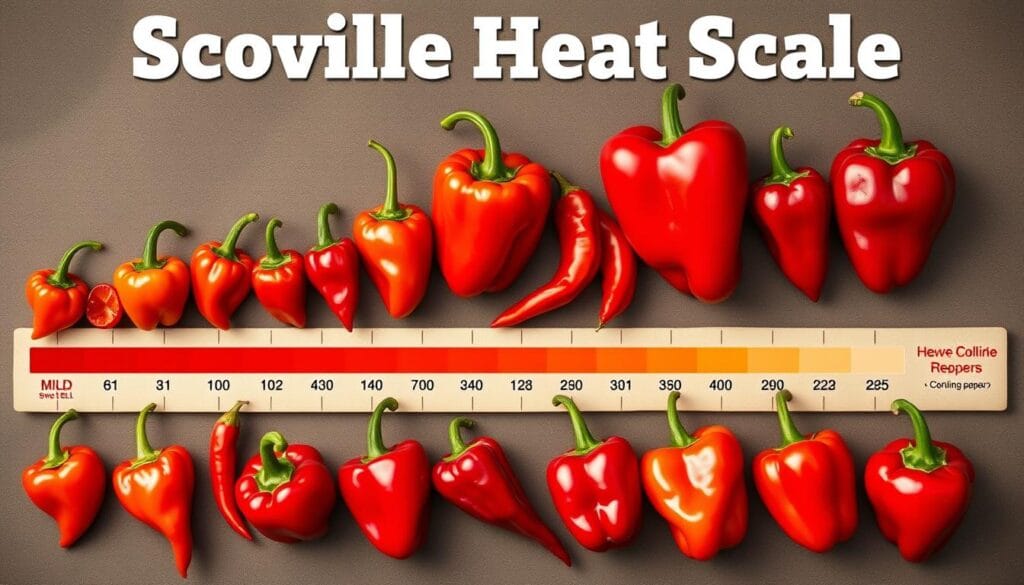
Discovering the heat of peppers is more than just taste. It’s a scientific journey that started in 1912 with Wilbur Scoville. The Scoville scale changed how we measure pepper heat, turning subjective taste into a precise system.
Exploring pepper history, the Scoville Heat Units (SHU) guide us through spiciness. This scale ranges from 0 SHU for sweet bell peppers to 16 million SHU for pure capsaicin.
“The hotter the pepper, the higher the SHU!” – Pepper Enthusiasts
Let’s look at the heat levels of different peppers:
- Sweet Bell Peppers: 0-100 SHU
- Jalapeños: 2,500-8,000 SHU
- Habaneros: 100,000-350,000 SHU
- Ghost Peppers: 855,000-1,463,000 SHU
- Carolina Reaper: 2,000,000-2,200,000 SHU
Modern science has replaced the old taste-test method with High-Performance Liquid Chromatography (HPLC). This method gives more accurate measurements of capsaicin. It ensures precise heat level documentation for both pepper enthusiasts and researchers.
Knowing the Scoville scale helps you pick peppers that fit your spice level. Whether you like mild flavors or seek out intense heat, the Scoville scale is your guide.
Mild to Medium Red Pepper Varieties
Red peppers come in a wide range of flavors and heat levels. They go from very mild to moderately spicy. This makes them perfect for any taste and cooking style.
Knowing the heat levels of peppers is key to picking the right one. The Scoville Heat Unit (SHU) scale helps you understand how spicy a pepper is.
Bell Peppers: The Mild Marvel
Bell peppers are the mildest, with a 0 SHU rating. They are full of nutrients and taste sweet and crisp. They’re great in salads, stir-fries, and as a snack.
- Zero heat level
- Excellent source of vitamin C
- Available in multiple colors
- Typical length: 3-6 inches
Anaheim Peppers: A Gentle Kick
Anaheim peppers have a mild heat, between 1,000 to 5,000 SHU. They’re perfect for those who want a bit of spice without too much.
Jalapeños: The Classic Spicy Pepper
Jalapeños have a medium heat, from 2,500 to 8,000 SHU. They add a spicy kick to many dishes. They’re a favorite in Mexican and Tex-Mex cooking.
| Pepper Variety | Heat Level (SHU) | Flavor Profile |
|---|---|---|
| Bell Peppers | 0 | Sweet, crisp |
| Anaheim Peppers | 1,000-5,000 | Mild, slightly tangy |
| Jalapeños | 2,500-8,000 | Spicy, robust |
“Peppers are not just about heat—they’re about flavor, nutrition, and culinary creativity.”
When picking peppers, think about how spicy you like them and what you’re cooking. Each type of pepper adds something special to your dishes. This lets you explore new flavors and recipes.
Hot Red Pepper Varieties and Their Uses
Explore the world of fiery red peppers and how they can change your cooking. From the mildly spicy cayenne to the extremely hot ghost pepper, these peppers add unique flavors and heat. They can make any dish better.
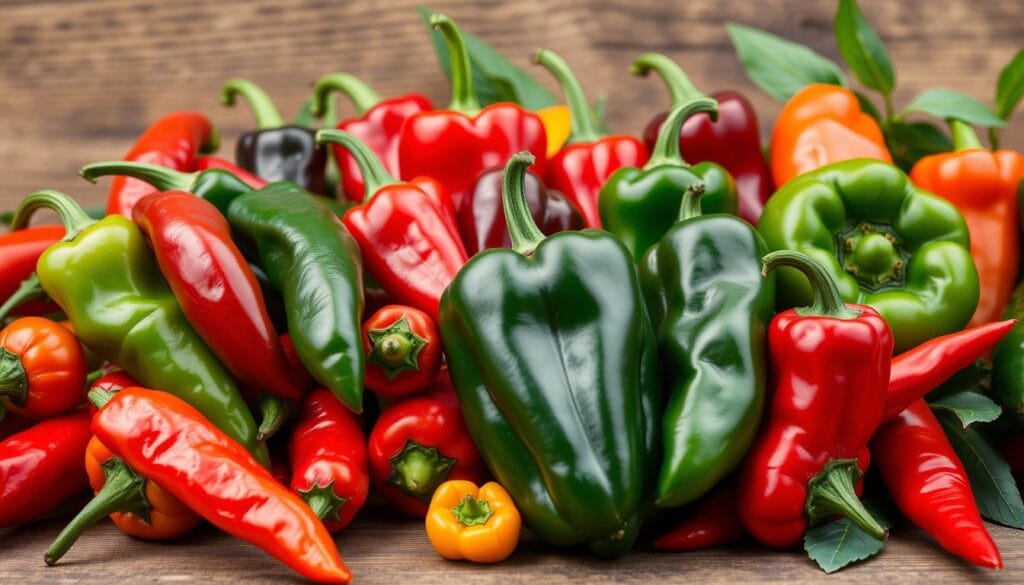
When looking at pepper varieties, knowing their heat levels is key. Here are some notable hot red peppers:
- Cayenne Peppers (30,000-50,000 SHU): A versatile pepper often used in dried or powdered form
- Thai Peppers (50,000-100,000 SHU): Tiny but intense, perfect for Southeast Asian cuisine
- Habanero Peppers (100,000-350,000 SHU): Known for their fruity, intense heat
- Ghost Peppers (1,000,000 SHU): Extremely hot, used sparingly in hot sauces
Peppers are more than just hot. They add complex flavors to marinades, sauces, and main dishes.
“The right pepper can transform a simple meal into a culinary adventure”
When handling hot peppers, wear gloves and avoid touching your eyes or sensitive skin. If you feel too much heat, try using dairy products like milk to cool down.
Whether you love spicy food or want to try new flavors, these hot red peppers are for you. Start with milder peppers and then try the hotter ones!
All You Need to Know About Peppers: Growing Guide
Growing peppers can be very rewarding. It doesn’t matter if you’re new or have lots of experience. Knowing how to grow peppers will help you get healthy, productive plants.
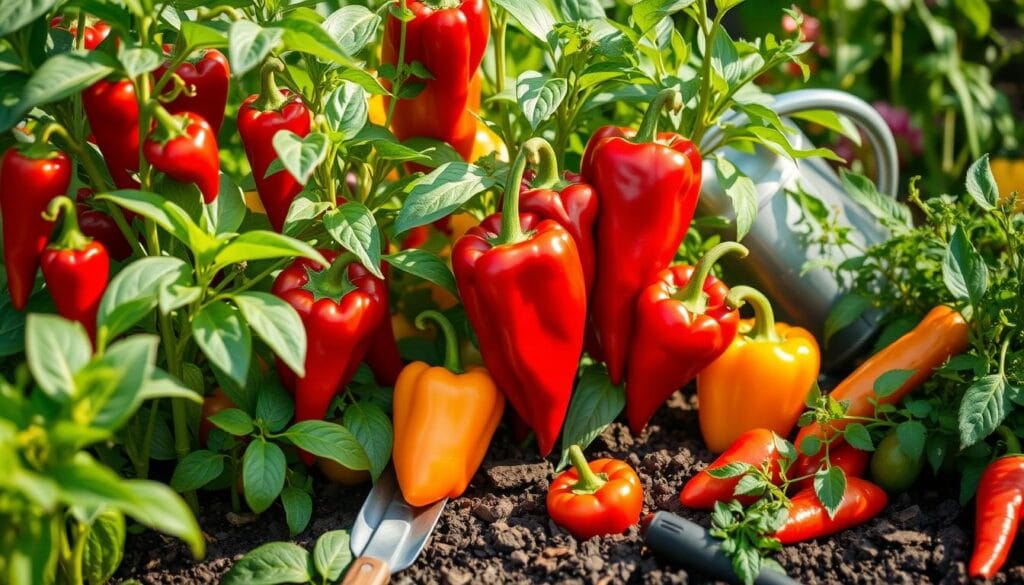
Optimal Growing Conditions
To grow peppers well, you need to know the best conditions. Peppers do best in certain temperatures and need the right growing conditions.
- Temperature: Optimal daytime range of 70-80°F
- Nighttime temperature: 65-70°F
- Sunlight: Full sun exposure (6-8 hours daily)
- Soil: Well-draining, rich in organic matter
Planting and Maintenance Tips
Pepper plants need careful planting and regular care. This ensures they grow strong and produce lots of peppers.
- Wait until the last frost has passed before planting
- Space plants 18-24 inches apart
- Use balanced fertilizer monthly
- Apply mulch to retain moisture
| Pepper Variety | Spacing | Sun Requirement | Harvest Time |
|---|---|---|---|
| Bell Peppers | 18-24 inches | Full Sun | 60-90 days |
| Jalapeños | 12-18 inches | Full Sun | 70-80 days |
| Anaheim Peppers | 18-24 inches | Full Sun | 70-80 days |
Harvesting Techniques
Harvesting peppers right is key for the best taste and plant health. Each type of pepper has its own signs for when to pick.
“The key to great peppers is knowing exactly when to pick them.” – Gardening Expert
- Bell peppers: Harvest when fully mature and firm
- Jalapeños: Pick when desired size and spiciness are reached
- Anaheim peppers: Harvest when full-sized and flavorful
By following these tips, you’ll grow a great pepper harvest.
Culinary Applications and Cooking Techniques
Peppers add vibrant flavors and heat to your cooking. They are perfect for exploring new recipes and uses in the kitchen. These colorful gems bring endless possibilities to your dishes.
Changing how you cook peppers can alter their taste. Roasting makes them sweet and smoky. Grilling adds a charred taste. Sautéing quickly releases their aroma, and pickling adds a tangy twist.
- Roast peppers to enhance natural sweetness
- Grill for a smoky, caramelized exterior
- Sauté for quick flavor release
- Pickle for a tangy twist
Peppers can be used in many ways, from simple garnishes to main courses. Here are some exciting ways to prepare them:
- Create vibrant salsas
- Stuff peppers with savory fillings
- Blend into smooth sauces
- Infuse oils with pepper essence
“A well-prepared pepper can elevate any dish from ordinary to extraordinary.” – Chef’s Secret
For pepper recipes, always taste as you go. The heat and flavor can change a lot between pepper types. Adjust to avoid making your dish too spicy.
Health Benefits and Nutritional Value
Red peppers are full of vitamins and minerals that boost your health. They are packed with essential nutrients. These vibrant veggies offer many health benefits, making them a great addition to your meals.
Vitamin Content and Antioxidants
One large red bell pepper is a nutritional powerhouse. It has:
- 233% of daily vitamin C recommendation
- 29% of daily vitamin A requirement
- 17% of daily vitamin E intake
| Nutrient | Amount per Large Red Pepper | Daily Value |
|---|---|---|
| Vitamin C | 210 milligrams | 233% |
| Iron | 0.71 milligrams | 4-9% |
| Potassium | 346 milligrams | 10% |
Medicinal Properties
Peppers have more than just basic nutrition. They contain strong antioxidants like:
- Capsanthin
- Lutein
- Zeaxanthin
“Antioxidants in peppers can help protect against chronic diseases and support overall health.” – Nutrition Experts
Potential Health Risks
While peppers are good for you, some might feel a bit sensitive in their stomach. If you have pollen allergies, talk to a doctor before eating more peppers.
Red peppers are low in calories (just 43 per large pepper) and 92% water. They are perfect for a healthy diet. They help your immune system, heart health, and might even lower the risk of age-related diseases.
Preservation Methods and Storage Tips
Learning how to preserve peppers can make your harvest last all year. Whether you have a lot of peppers from your garden or want to save your favorites, knowing how to store them is key.
Freezing Peppers
Freezing is a simple way to keep peppers fresh. Here’s how to do it right:
- Wash and dry peppers well
- Take off stems and seeds
- Cut or slice as you like
- Do a flash freeze for 1-2 hours on a baking sheet
- Put them in freezer-safe containers
Dehydrating Methods
Dehydrating is a great way to save space while keeping peppers fresh. Use a dehydrator at 125° F to keep their color and taste:
| Dehydration Time | Pepper Texture | Best Use |
|---|---|---|
| 4-5 hours | Leathery | Rehydration for cooking |
| 12-13 hours | Brittle | Grinding into powder |
Pickling and Fermentation
Pickling is a great way to add flavor to your peppers. Make a brine with:
- 3/4 cup vinegar
- 3/4 cup water
- 1 tbsp kosher salt
- Optional: 2 tbsp sugar, spices
“Proper preservation transforms your pepper harvest into a year-round culinary adventure.” – Pepper Preservation Expert
Always follow safety rules when preserving peppers. Use clean tools and follow jar processing steps to avoid food safety issues.
Conclusion
Red peppers open up a world of flavors and heat levels. They range from mild bell peppers to hot Habaneros. This journey shows the amazing variety in the pepper family.
Gardeners and food lovers find a wide range of peppers. With 126 types and heat levels from 2,000 to 575,000 Scoville Heat Units, there’s much to try. Growing peppers or making spicy sauces, they add fun and nutrition.
Peppers mean more than just food. They connect us to global foods, farming, and health. Exploring different peppers, you learn about their unique flavors and uses. This knowledge leads to new cooking and gardening adventures.
Red peppers are more than vegetables. They introduce us to global foods, our tastes, and farming progress. By exploring these plants, you’ll change how you cook, garden, and enjoy peppers.
FAQ
What is capsaicin and why do peppers have heat?
Capsaicin is the chemical that makes peppers hot. It makes your mouth feel like it’s burning. The more capsaicin a pepper has, the hotter it is. This heat is measured on the Scoville scale.
But here’s the cool thing: capsaicin doesn’t actually make peppers hot. It just makes your body think they are.
How do I choose the right pepper for my recipe?
Think about how hot and tasty you want your dish to be. Bell peppers are mild and good for salads. Jalapeños add a bit of heat.
For a real kick, try habaneros or cayenne. Always check the Scoville Heat Unit (SHU) to know how spicy a pepper is.
Can I grow peppers in my home garden?
Yes! Peppers love sunlight, good soil, and warm weather. Start seeds indoors 8-10 weeks before it’s too cold outside.
Move them outside when it’s safe, and keep the soil moist. You can grow them in pots or in the ground.
What are the health benefits of eating peppers?
Peppers are full of vitamins A and C, and antioxidants. They might help your body fight off sickness and pain.
Red peppers are especially good because they have beta-carotene and lycopene.
How can I preserve peppers for long-term storage?
You can dry, freeze, pickle, or can peppers. Pick the method that fits your needs and the pepper type. This way, you can enjoy peppers all year.
Are pepper seeds really the spiciest part of the pepper?
No, it’s not the seeds that are the hottest. The white membrane around the seeds has the most capsaicin. Seeds might seem spicy because they’re close to this membrane, but they’re not actually hotter.
What is the Scoville scale, and how does it work?
The Scoville scale measures how hot peppers are by checking capsaicin levels. It used to be based on taste tests, but now it uses special equipment.
Bell peppers are 0 SHU, and pure capsaicin is 16 million SHU. This scale helps us compare pepper heat levels.
How can I reduce the heat in a spicy pepper dish?
Use dairy like milk, yogurt, or sour cream to cool down the heat. Don’t use water, as it can make things worse. You can also remove seeds and membranes before cooking.
Mix spicy peppers with milder ones to balance the heat. Starchy foods like rice can also help tone down the spiciness.
Source Links
- https://miraclegro.com/en-us/growing-plants/Exploring-the-world-of-peppers.html?srsltid=AfmBOorYhuTTsEtjWo_zZgg6vrarMmATfHieshsf6QHy7TbCrxLfb85j – Exploring the World of Peppers
- https://thecottagepeach.com/blog/how-to-grow-pepper-plants-garden – How To Grow, Harvest and Store Peppers [Guide]
- https://cruciblecookware.com/blogs/tips-and-inspiration-for-cookware-cooking-baking/what-different-types-of-peppers-are-there?srsltid=AfmBOopvk6a8ORGHo14PuybeF34yJsfLtBtEl0B5_mJjzwLCMnyUsYPc – What Different Types of Peppers are There?
- https://en.wikipedia.org/wiki/Capsaicin – Capsaicin
- https://www.culturehotsauce.com/blogs/educate-yourself/capsaicin?srsltid=AfmBOooQ-TkC3Eb6S6C-pFqxp3hra-BP6pfEgBTc6N5CHqemUJGsUIVR – Capsaicin
- https://pepperjoe.com/blogs/blog/hot-pepper-heat-scale-and-the-scoville-scale – Hot Pepper Heat Scale and the Scoville Scale
- https://www.simplytexan.com/searing-tongues/the-scoville-scale-explained/ – Scoville Scale Explained: Measuring Pepper Heat from Mild to Wild
- https://www.liveeatlearn.com/types-of-pepper/ – 29 Types of Peppers from Mild to Hot (With Photos!)
- https://www.tasteofhome.com/article/guide-to-peppers-from-sweet-to-spicy/?srsltid=AfmBOoq5hVuwLDtbqeq2yeShd27vvd4CRHQrolAzDgC-XRyYh8OoQvuJ – Here’s Every Type of Pepper You Need to Know
- https://www.webstaurantstore.com/article/910/types-of-peppers.html?srsltid=AfmBOorRPbCq8rRAzAVILOZvXioEFOmN9D9FQh_PQDJ2a5FrT1r0hOiZ – Types of Peppers
- https://www.webstaurantstore.com/article/910/types-of-peppers.html?srsltid=AfmBOorNZYySQsdT-5j3CgjNTaLC3HbezY1HiqT-GicVruJ2WNDCGCSg – Types of Peppers
- https://www.epicurious.com/expert-advice/types-of-peppers – 18 Types of Peppers and How to Cook With Them
- https://www.escoffier.edu/blog/culinary-arts/a-basic-guide-to-hot-peppers/ – The Ultimate Guide to Hot Peppers
- https://www.almanac.com/plant/bell-peppers – How to Grow Bell Peppers: The Complete Guide
- https://www.creativevegetablegardener.com/growing-sweet-peppers/ – Essential Guide to Growing Sweet Peppers
- https://www.applewoodnursery.com/2024/05/06/the-complete-guide-to-growing-your-own-peppers/ – The Complete Guide to Growing Your Own Peppers – Applewood Nursery & Landscape Supply
- https://www.reluctantgourmet.com/pepper/ – The Ultimate Guide to Pepper: Types, Uses, and Storage Tips
- https://www.justmaikacooking.com/cooks-notebook/prepping-chili-peppers/ – How to Prepare Chili Peppers – Just Maika Cooking
- https://www.health.com/bell-peppers-benefits-8624590 – 4 Ways Bell Peppers Can Boost Your Health
- https://www.healthline.com/nutrition/foods/bell-peppers – Bell Peppers 101: Nutrition Facts and Health Benefits
- https://pepperjoe.com/blogs/grow-with-joe/3-ways-to-preserve-and-store-peppers – How to preserve and store peppers in 3 Simple Ways
- https://gubbahomestead.com/food-preservation/the-ultimate-guide-to-making-fermented-peppers/ – The Ultimate Guide to Making Fermented Peppers
- https://extension.oregonstate.edu/food/preservation/preserving-peppers-sp-50-454 – Preserving Peppers (SP 50-454)
- https://www.sonoranspice.com/blogs/sonoran-spice-product-guides/wiri-wiri-peppers?srsltid=AfmBOoqFC2pAGkxBv3bRJEdl_esbvH9Z-NXJQff4GGHsqIqlAUwdqRvY – All You Need to Know About Wiri Wiri Peppers
- https://thetomatoladyblog.com/category/peppers/ – Peppers – Notes From The Tomato Lady

